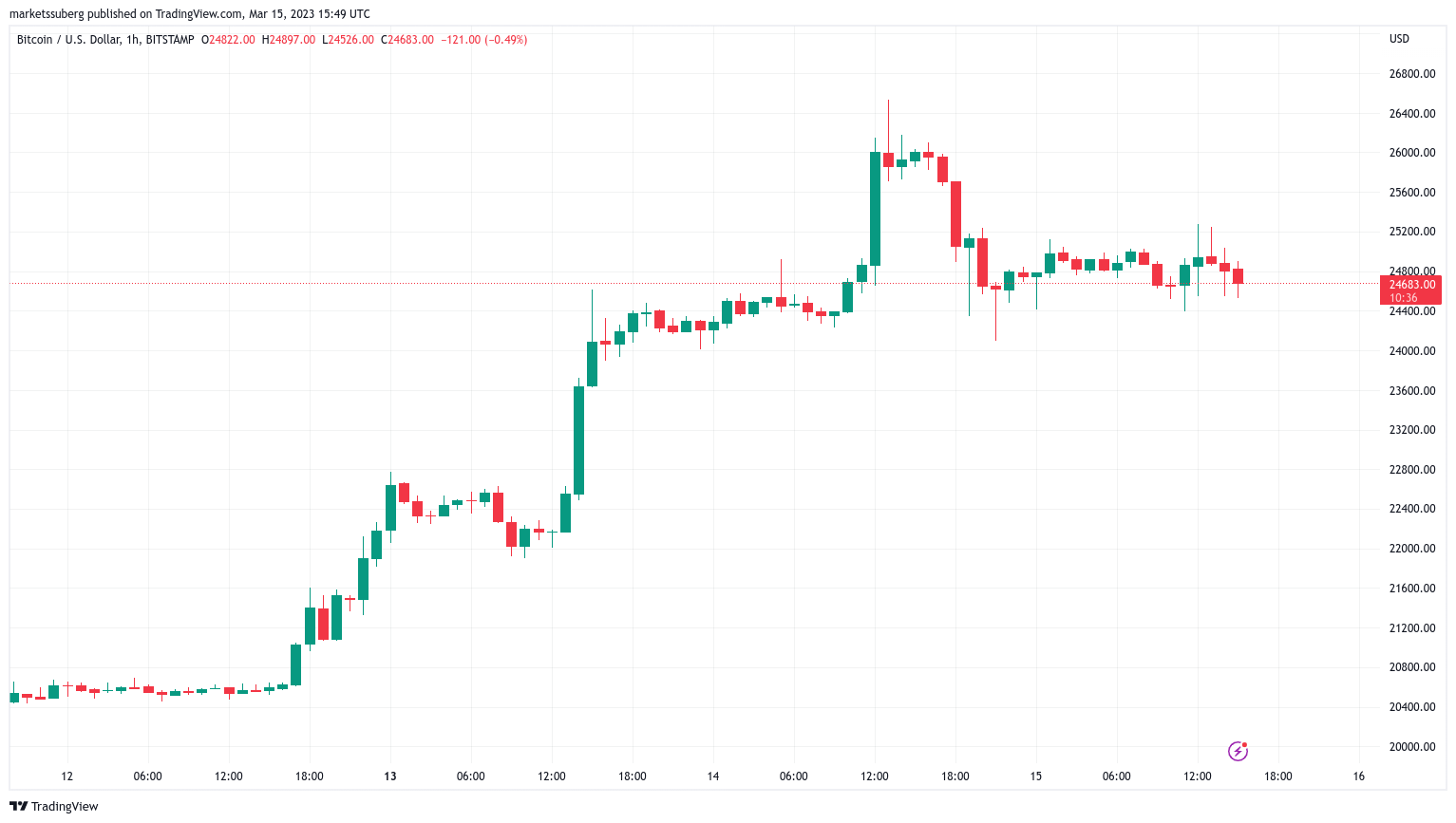
Bitcoin (BTC) kept bears sweating near $25,000 as encouraging macroeconomic data combined with concerns over banking crisis contagion.

PPI offers “great signs” on Fed pivot
Data showed BTC/USD recovering from a 24-hour comedown to see highs of $25,273 on Bitstamp.
The pair reacted positively to the latest United States Producer Price Index (PPI) data, which came in far lower than expected.
Prior to the release, the Binance order book showed principal bid and ask liquidity parked at $22,000 and $26,000, respectively.
“Time will tell if enough bid liquidity is there to insulate $22k from getting hit,” on-chain monitoring resource Material Indicators wrote in part of an accompanying commentary while uploading the data to Twitter.

For Cointelegraph contributor Michaël van de Poppe, founder and CEO of trading firm Eight, signs were there for the Federal Reserve and Chair Jerome Powell to abandon interest rate hikes at next week’s decisive meeting.
“PPI comes in at 4.6%, while 5.4% was expected. Massive miss, resulting into inflation coming down. Powell to pivot?” he queried.
“Atleast 25bps seems very likely (or no hikes with the banking issues). Great signs!”
The PPI joined already buoyant Consumer Price Index data released the day prior, which accompanied nine-month highs for Bitcoin as crypto took full advantage of the unfolding U.S. banking crisis.
A day later, however, the focus was Europe as European bank stocks were halted for volatility and one in particular, Credit Suisse, hit new record lows.
Credit Suisse was down over 25% at one point before a reversal took it above the $2 mark.
WTF? The markets are now pricing in a probability of default of 47% for Credit Suisse. What have I missed? pic.twitter.com/Q2MMo0T3LV
— Holger Zschaepitz (@Schuldensuehner) March 15, 2023
“Silicon Valley Bank had about $209 billion in assets. Credit Suisse has about $578 billion in assets,” Genevieve Roch-Decter, CEO of financial insights firm Grit Capital, commented on the situation.
“This is a much bigger problem in the making.”
Dollar climbs, ignores U.S. inflation data
Crypto, meanwhile, faced headwinds from an arguably unlikely source on March 15 in the form of surging U.S. dollar strength.
Despite the economic data print showing declining inflation and more favorable conditions for risk assets, the U.S. Dollar Index (DXY) hit 105 for the first time since the Silicon Valley Bank implosion on March 1
Markets commentator Tedtalksmacro pinned the blame firmly on Europe’s banking troubles.
“Banking contagion is now spreading to Europe, euro bond yields sharply lower and therefore EUR is also sharply lower,” part of a tweet read.
“The EUR makes up 58% of the DXY. So EUR down = DXY up!”
The DXY measures dollar strength against a basket of major trading partner currencies. Its performance is traditionally inversely correlated with crypto markets.

The views, thoughts and opinions expressed here are the authors’ alone and do not necessarily reflect or represent the views and opinions of Cointelegraph.
Check other news for today and Please stand by..
*********************************
If one of the paying programs on our Monitor appeals to you, please support EmilyNews by registering for it on our website. Thanks very very much!
EN web Support Chat | Hyips and Crypto questions – HyipChatEN
Telegram Chat for Crypto and Hyip reports: @HyipChatEN
*********************************
Be the first to get most important HYIP news everyday!
Simply Follow EN Facebook, EN Telegram, EN Twitter
or Subscribe to EN Feedburner and submit your email address!
If you like this article and want to support EN – please share it by using at least few of social media buttons below. Thanks and See you tomorrow!

